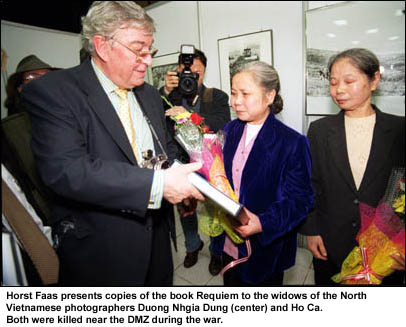|
by Horst Faas
The opening ceremony was attended by widows of Vietnamese photographers who died during the war, Vietnamese generals, many Vietnamese officials and some 350 guests, among them Russell Burrows, son of Larry Burrows, and Dorothy and Alan Reese, wife and son of Everette Dixie Reese. There was a minute of silence for all the dead and moving speeches by Vietnamese officials who worked with us to make the exhibition possible, as well as remarks by Richard Lennon and myself. The opening ceremony was carried almost in full on Vietnam National Television. Richard Lennon represented the Commonwealth of Kentucky and the Steering Committee of the "Requiem - The Vietnam Collection" project, the group of Kentuckians, all Vietnam war veterans, who organised the financial support that made it all possible.
As the book is not available in Vietnam (it still costs about as much as a good monthly salary in Vietnam) we brought several copies to Vietnam and displayed them for all to read and see on tables in the exhibition rooms. Young and old Vietnamese crowded every day around these books, often copying the texts by hand. I was told frequently by Vietnamese, young and old, that this was the first opportunity to see photographs of the real face of the Vietnam war - and indeed many looked at each picture for a long time. Many old men brought their children and grandchildren, and as at exhibitions elsewhere we witnessed some unashamedly emotional scenes. The Vietnamese visitors were joined by many tourists, who had learned about the exhibition through repeated CNN reports and the local English and French language papers. At a press conference and a forum discussion with Vietnamese photographers the questions were fair and open - and we did not hear a single provocative or critical remark. There was a lot of curiosity about what attracted photographers and newsmen from around the world to cover the Vietnam war. We tried to explain.
Of course, there were some problems - most of which we could overcome. The committee which made the final decision which pictures could NOT be displayed ruled not to show anything from Cambodia and Laos. The explanations we got were evasive. Discussion was not possible. We managed, at last minute, to get the early Cambodia pictures of Everette Dixie Reese back into the exhibit. We did, however, show the portraits of Cambodian photographers. South Vietnamese photographers were exhibited as we wished - and the honour roll was not questioned. Furthermore, we could show all photographs in the books and could also show the computer generated digital presentation of the exhibition, which included the key Cambodian and Laos pictures, continuously throughout the first four days of the exhibition (then we had to take our equipment home). Media coverage was grand - Vietnamese newspapers carried big displays, including Nhan Dan and the party Lao Dong newspaper; all television and radio stations seemed to be present. From the international press CNN, Reuters Television, APTN and ZDF, a German TC station had sent representatives, beefing up coverage from the locally based agencies, as Reuters, AFP, AP, DPA. It was a disappointment that (except for many American tourists) the official presence of the U.S. in Hanoi, the U.S. Embassy and others, although invited, seemed to ignore the event. Nobody came or called. We had hoped to find some sponsorship from US companies in Hanoi to finance the HCM leg of the exhibit. We suggested to our partners in Vietnam
to show the exhibit permanently, preferably in Hanoi, HCM City or Hue.
I was assured that the exhibit would travel to other Vietnamese cities,
and possibly be shown permanently, funding permitting.
|
 What
was two years ago an utopian dream has become reality: On March 10 the
photographs of our book "Requiem by the Photographers Who Died in Vietnam
and Indochina" went on public exhibition in Hanoi, along with many of the
portraits of the photographers and excerpts from the texts in Requiem.
What
was two years ago an utopian dream has become reality: On March 10 the
photographs of our book "Requiem by the Photographers Who Died in Vietnam
and Indochina" went on public exhibition in Hanoi, along with many of the
portraits of the photographers and excerpts from the texts in Requiem.
 In
the main entrance hall the large boards with the names of the dead photographers
of Vietnam and of all other nations flanked incense burners, flowers and
a display of the photographers' portraits. The flag of Kentucky was placed
beside the flag of Vietnam.
In
the main entrance hall the large boards with the names of the dead photographers
of Vietnam and of all other nations flanked incense burners, flowers and
a display of the photographers' portraits. The flag of Kentucky was placed
beside the flag of Vietnam.
 The
exhibition, prints, frames and all, are now in the hands of the Vietnamese,
specifically of the Association of Artistic Photographers in Vietnam and
the Vietnam News Agency, who supported our project and this exhibition.
We were delighted to hear from them during the opening ceremonies a pledge
and commitment to open the exhibition on May 5, 2000, for 14 days in Ho
Chi Minh City. The funds left over after Hanoi at present do not cover
all expenses for HCM City (Saigon), but I am certain that somehow the miracle
will repeat itself.
The
exhibition, prints, frames and all, are now in the hands of the Vietnamese,
specifically of the Association of Artistic Photographers in Vietnam and
the Vietnam News Agency, who supported our project and this exhibition.
We were delighted to hear from them during the opening ceremonies a pledge
and commitment to open the exhibition on May 5, 2000, for 14 days in Ho
Chi Minh City. The funds left over after Hanoi at present do not cover
all expenses for HCM City (Saigon), but I am certain that somehow the miracle
will repeat itself.